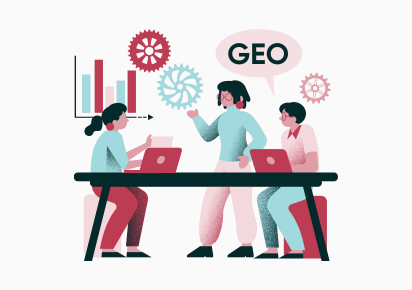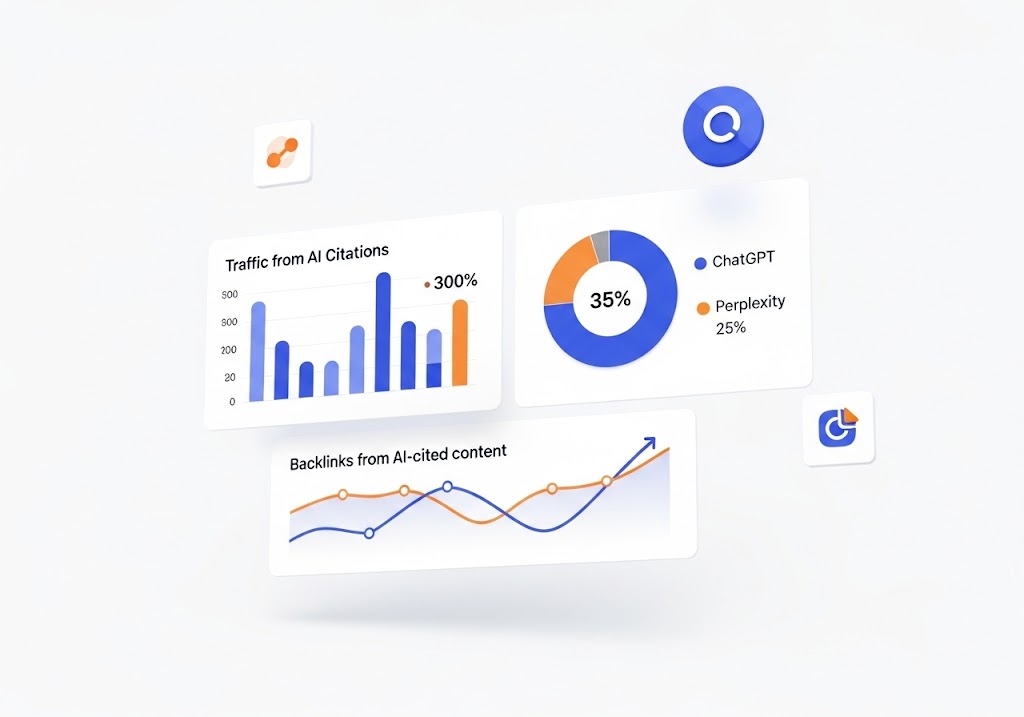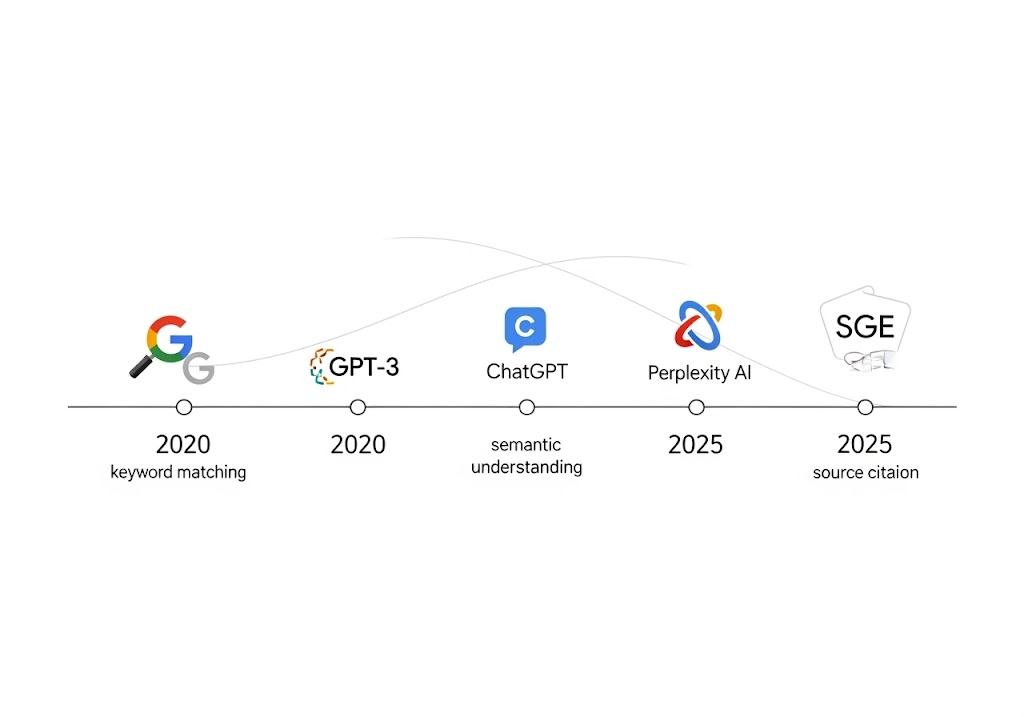Our Links Are Trusted By 2,500+ SEO Agencies
Our Links Are Trusted By 2,500+ SEO Agencies
By the Rhino Rank team
30th Jul 2025

Generative Engine Optimization (GEO) enhances your content’s visibility in AI-driven search engines. Unlike traditional SEO, GEO makes sure AI cites your content, boosting visibility and engagement.
In this article, learn what GEO is and why it’s key to adapting your SEO strategies for the future. ChatGPT alone surpassed Bing in visitor volume, receiving more than 10 million queries per day – so focusing on GEO is crucial for success.
Generative Engine Optimization (GEO) focuses on enhancing content visibility in AI-driven search engines, moving beyond traditional SEO’s keyword-centric approach to prioritize contextual relevance and user intent.
Implementing structured data and utilizing Large Language Models (LLMs) are essential for optimizing content, ensuring AI algorithms understand and prioritize it, thus improving brand visibility and user engagement.
Regular performance tracking and adapting strategies based on user feedback are crucial for successful GEO, enabling businesses to refine content and maintain a competitive edge in an evolving digital landscape.
Generative Engine Optimization (GEO) is revolutionizing the way brands achieve visibility in AI search engines. Unlike traditional search engine optimization, which primarily focuses on ranking higher in search engine results pages, GEO aims to provide the best possible content for AI-driven platforms. This means producing content that is not just indexed but actively cited by AI systems, resulting in ai generated results.
The goal of GEO is to enhance brand awareness and user experience by aligning with AI-driven search engines. This involves creating content that appeals to both humans and machines, ensuring that it is not only valuable but also easily understood by AI algorithms. For businesses, effectively implementing GEO is crucial to maintaining a competitive edge in an increasingly AI-dominated environment.
To fully grasp the significance of GEO, understanding its components and integration with traditional SEO practices is necessary. While GEO includes transferable SEO elements, it also introduces unique strategies tailored for AI models. Next, we will explore what GEO is and how it differs from traditional SEO.
Generative Engine Optimization (GEO) represents the next evolution in optimizing content for AI responses. Unlike traditional SEO, which aims to improve rankings in search engine results, GEO focuses on enhancing visibility in AI-driven search engines. Aligning content with generative AI mechanisms ensures information is found and cited by AI systems, enhancing brand awareness and user experience through the geo process.
The primary focus of GEO is to produce content that directly addresses user intent, providing answers that are both accurate and contextually relevant. This involves utilizing structured and well-informed content to enhance visibility in generative AI search engines. As a result, GEO efforts help brands stay competitive and maintain their visibility in an AI-driven digital landscape.
While both GEO and traditional SEO aim to increase visibility, their approaches differ significantly. GEO emphasizes discoverability for AI-generated content, prioritizing context and relevance over traditional keyword-focused methods. This shift in focus means that GEO relies heavily on large language models and semantic clarity to generate contextually relevant content, highlighting the geo and seo similarities.
Traditional SEO focuses on improving rankings through keyword optimization and backlinks, replacing SEO in the process. In contrast, GEO optimizes content to ensure it is cited by AI systems, making consumer actions more about reading AI-generated answers than clicking through to websites.
While GEO is not a replacement for SEO, it is an extension that integrates traditional SEO practices with new strategies tailored for AI-driven search engines.

To effectively optimize for generative search engines, it’s essential to understand how these engines work. Generative engines like ChatGPT are based on Large Language Models (LLMs), which use extensive neural networks to craft meaningful responses. These advanced machine learning models analyze and understand user queries, producing human-like answers through deep learning algorithms designed to process natural language.
As search behavior evolves, users are increasingly using longer, conversational user’s query, including complex queries. 71% of Americans now use AI to search for information online. This shift reflects the growing importance of generative engines in providing contextually rich and relevant responses. By 2025, a significant portion of searches will utilize voice or image-based queries, highlighting the need for businesses to adapt their strategies to these changing interactions.
We will now explore the role of large language models and natural language processing in the context of GEO, offering a deeper understanding of generative engine mechanics.
Large language models (LLMs) are at the heart of generative engines, playing a crucial role in interpreting information from content and providing relevant answers. Unlike traditional search engines that prioritize click-through behavior and backlinks, LLMs focus on contextual relevance, ensuring that the responses generated are meaningful and valuable.
Built using transformer architectures, LLMs can identify relationships in data regardless of their position in the sequence. This allows them to generate contextually accurate content that aligns with user queries, making GEO efforts more effective in enhancing brand visibility and user experience.
Natural Language Processing (NLP) is essential for generative engines to understand and interpret user queries. Leveraging structured data, NLP enables AI-driven platforms to quickly grasp the context and relationships within the content. This enhances the interaction experience, as users can input queries in a more natural, conversational manner.
As AI algorithms continue to advance, their ability to analyze and understand user intent and context will improve, further enhancing the effectiveness of GEO. Structured data not only aids in comprehension but also increases the likelihood of content being included in synthesized AI responses, making it a critical component of any GEO strategy.
A successful GEO strategy involves multiple components that work together to optimize content for AI-driven models:
Creating valuable and informative content to attract both users and generative engines.
Regularly updating content to maintain its relevance.
Boosting content performance in generative search results through these practices.
Generative search engines encourage users to enter queries in a conversational manner, enhancing the interaction experience. By integrating various components tailored for AI-driven models, businesses can effectively implement a GEO strategy that enhances visibility and user engagement.

High-quality content is the cornerstone of any effective GEO strategy. Content that is engaging, informative, and well-structured enhances visibility in generative search engines. This includes landing pages, informational pages, and user-generated content, all of which contribute to a comprehensive and appealing digital presence.
Structured data plays a vital role in improving search engines’ understanding of content, which can lead to higher visibility in search results. By establishing authority and expertise, businesses can create content that is not only helpful but also highly credible, further enhancing its effectiveness in generative AI-scannable responses.
Personal experience and extensive research are crucial for creating high-quality content. Whether you are an expert in a topic or conducting thorough research, the goal is to produce content that directly addresses user queries and provides comprehensive answers. This not only improves user engagement but also increases the likelihood of being cited by AI systems.
Keyword research remains a fundamental aspect of both traditional SEO and GEO. Thorough keyword research helps grasp user search intent, allowing businesses to optimize their content accordingly. By identifying relevant topics that align with user interests, brands can improve their GEO strategies and enhance their visibility in AI-driven search engines.
Utilizing keyword research tools can help businesses identify the topics that are most relevant to their audience, ensuring effective keyword usage that makes the content produced both engaging and effective in attracting users and generative engines alike.
Understanding and addressing user intent is crucial for boosting engagement and visibility in GEO. By tracking metrics like time spent on the page and interaction rates with generated content, businesses can assess user engagement and optimize their content strategies.
Audience feedback, such as comments and surveys, provides qualitative insights into how users perceive generative content. This feedback is invaluable for refining content to better align with user intent and improve overall engagement.
The technical aspects of GEO are critical for ensuring that content is easily understood and effectively indexed by AI systems. Utilizing structured data enhances the understanding of content for both search engines and AI tools. This increases the chances of content appearing in rich search results and AI-generated responses.
Headings, bullet points, and other structured text elements can be utilized by generative search engines to improve content comprehension and visibility. By focusing on structuring content for online reading, businesses can hook readers and draw interest to preferred sections, enhancing overall engagement.
Structured data is essential for making content understandable and trustworthy to AI systems. By providing context and structure, structured data aids generative engines in comprehending the content, increasing the likelihood of it being included in synthesized AI responses.
Enhancing content comprehension through structured data not only improves visibility but also ensures that the information provided is accurate and reliable. This is crucial for maintaining user trust and engagement in an AI-driven digital landscape.
Schema markup serves to communicate with bots, providing essential data and context that enhance understanding. By adding structured data through schema markup, website owners can effectively improve how their content is interpreted by AI algorithms, influencing the appearance of rich results and AI-generated overviews.
Implementing schema markup is crucial for optimizing search engine performance and enhancing user experience through better data representation. This not only improves visibility but also boosts user engagement by providing more relevant and contextually accurate information.
Generative engine optimization is essential for increasing brand visibility and authority, leading to higher conversion rates compared to traditional methods. Optimizing for generative models can result in better content performance and higher conversion rates, positioning brands more favorably within their markets.
A well-structured technical framework enhances the accuracy of AI-generated information, ensuring brand consistency and improving ai visibility across various digital ecosystems. The integration of GEO with traditional SEO practices is becoming essential, as both methods complement each other for maximum visibility.
Digital PR contributes significantly to establishing brand authority in the context of generative engine optimization. By building brand authority, businesses can enhance their visibility and credibility, making it easier for both traditional SEO and GEO practices to reach target audiences.
Effective digital PR strategies involve creating high-quality content, engaging with the audience, and leveraging media coverage to boost brand mentions and authority. This not only improves visibility in search results but also enhances user engagement and trust through marketing efforts.
Generative AI uses social media signals to rank and index content, making content distribution on platforms like Reddit essential for visibility. Marketing on Reddit provides businesses with opportunities to influence large language models, ensuring their content is cited and ranked favorably.
Distributing content on platforms like Reddit and Quora can significantly impact how AI engines and traditional search engines rank this content. Recent studies have revealed that Reddit is the top sourced URL for content, highlighting the importance of leveraging social media for effective GEO strategies.
Effective performance tracking in GEO is crucial for capitalizing on opportunities created by generative engines. Continuous data and outcome monitoring allow businesses to fine-tune their GEO strategies, enhancing visibility and engagement. Tracking performance highlights the value of GEO by showing how well content performs in AI-driven environments.
Generative engines improve user experience by using ongoing interactions, user feedback, new data inputs, and search engine results, making content more likely to appear in search results. Additionally, AI driven engines enhance this process further.
The following subsections will explore the tools and methods for tracking GEO performance and data analysis of user engagement.
Tools like HubSpot’s AI Search Grader and Google Analytics 4 are invaluable for assessing content effectiveness and user engagement. HubSpot’s AI Search Grader offers the following features:
Evaluates website content for optimization in AI search engines
Provides insights on visibility and competitive positioning
Assesses content quality, structure, and relevance
Assists businesses in improving their AI search performance.
Google Analytics 4 helps examine user interactions, traffic sources, engagement, and conversion rates, which are essential for assessing the effectiveness of content in reaching target audiences. SERPWatcher provides daily updates and a performance index to gauge potential traffic from specific keywords, enhancing tracking capabilities for GEO.
Effective performance tracking is crucial for successful generative engine optimization efforts.
Evaluating user engagement through metrics and feedback is crucial for optimizing content strategies. By assessing how often content appears in AI citations and tracking user interactions, businesses can gain insights into the effectiveness of their GEO efforts. Tools like the Hemingway app can help improve clarity in writing, enhancing user engagement.
Readers typically engage with online content by skim-reading for headings, bullet points, or images. Evaluating content performance is essential for understanding user engagement and optimizing content strategies. This involves using metrics and feedback to refine content, ensuring it aligns with user intent and provides value.

Effective generative engine optimization involves clear headings, concise paragraphs, and lists to improve user experience. Using well-sourced information and structuring content with AI-friendly elements like structured data enhances readability and engagement.
Combining good content practices with E-E-A-T (Experience, Expertise, Authoritativeness, Trustworthiness) helps achieve better visibility and credibility in generative engines.
Keyword stuffing negatively impacts both SEO and GEO, making it crucial to avoid keyword stuffing practice. Natural keyword integration enhances the user experience and aligns better with generative engines, ensuring content is both relevant and engaging.
Focusing on creating helpful content that naturally incorporates keywords enables businesses to enhance both SEO and GEO efforts. This approach not only enhances visibility but also boosts user engagement and satisfaction.
Optimizing content for readability is essential for improving engagement and comprehension. Visual and interactive elements like images, interactive elements, and infographics can significantly enhance user experience, making content more engaging and easier to understand.
Short, focused sections improve comprehension and retention of information, making it more likely that users will engage with and share the content. Engaging writing styles can further increase the likelihood of content being shared and recommended, amplifying its reach and impact.
The landscape of generative engine optimization will continue to evolve with advances in AI technologies and changing user behaviors. Adapting to these changes is crucial for marketers to stay competitive. Best practices for geo methods are expected to emerge as the field evolves, making it essential to keep an eye on emerging techniques.
Google’s prioritization of E-E-A-T (Experience, Expertise, Authoritativeness, Trustworthiness) in the context of generative engine optimization highlights the importance of maintaining high standards of content quality and credibility. 40.58% of AI citations come from Google’s top 10 results – and Google prioritises E-E-A-T when ranking articles.
Next, we will explore future advancements in AI algorithms and the integration of GEO with traditional SEO.

Next-generation AI will likely incorporate predictive capabilities to tailor search results in real-time. SEMrush’s AI toolkit provides strategic recommendations inspired by large language models, helping businesses stay ahead in the evolving landscape of generative engine optimization.
Advancements in AI algorithms are expected to significantly enhance GEO strategies, transforming how content is tailored and optimizing user engagement. These advancements will ensure that generative engines prioritize content that is contextually relevant and valuable to users, enhancing overall visibility and engagement, including ai overviews and ai generated outputs.
Aligning content with user intent is crucial for optimizing visibility across both generative and traditional search engines. Digital PR helps build brand authority, making it easier for both traditional SEO and GEO practices to reach target audiences.
Distributing content across social media platforms enhances engagement and influences how AI engines and traditional search engines rank this content. By integrating GEO with traditional SEO practices, businesses can maximize their visibility and ensure that their content is effectively promoted across various digital ecosystems.
As generative AI continues to transform the digital landscape, understanding and implementing Generative Engine Optimization (GEO) is essential for maintaining visibility and competitiveness. This guide has explored the mechanics of generative engines, key elements of an effective GEO strategy, technical aspects, and future trends.
By combining traditional SEO practices with emerging GEO techniques, businesses can enhance their online presence and engage more effectively with their target audience. Embracing these strategies will ensure that your brand remains at the forefront of the digital revolution, ready to thrive in an AI-driven world.
Generative Engine Optimization (GEO) is essential for boosting your content’s visibility in AI-driven search engines, making sure it’s recognized and valued by these systems. Embracing GEO can significantly enhance your brand’s presence and improve user engagement!
GEO differs from traditional SEO by focusing on the discoverability of AI-generated content through context and relevance rather than just keywords and backlinks. Embrace this shift to enhance your content’s visibility and relevance in the digital landscape!
High-quality content is crucial for GEO because it boosts engagement and credibility, leading to higher visibility and citations by AI systems. Invest in your content to stand out and thrive in the digital landscape!
To effectively track your GEO performance, utilize tools like HubSpot’s AI Search Grader and Google Analytics 4, as they provide valuable insights into content effectiveness and user engagement. Start leveraging these tools today to optimize your strategies!
To effectively integrate GEO with traditional SEO, align your content with user intent and share it across social media to boost engagement. This approach will positively impact how both AI engines and traditional search engines rank your content, driving more visibility for your business.

Join 18,000+ Businesses Growing with Rhino Rank
Sign Up